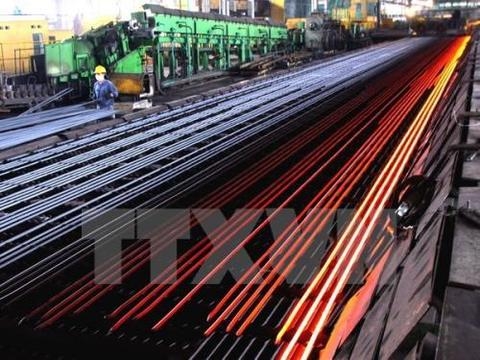Strong growth for steel production
 |
| Steel being manufactured at Viet Duc Steel Co in the northern province of Vinh Phuc. - VNA/VNS Photo Huy Hung |
Steel production output in the first four months reached 3.21 million tonnes, a year-on-year increase of 8.8 per cent, including 850,000 tonnes in April. Meanwhile, the steel industry’s consumption stood at 3.07 million tonnes in the period, a year-on-year surge of 12.9 per cent, including 830,000 tonnes in April.
The industry had optimistic results in exports also. In the first three months of this year, the value of steel exports exceeded US$1 billion, with the exports on an upward trend. Meanwhile, selling prices in April were stable in both north and south.
The Cong thuong (Industry and Trade) newspaper quoted Nguyen Van Sua as saying the price of raw materials in the world had fluctuated to affect directly the price of steel in the domestic market. The industry imports many raw materials for domestic steel production, such as steel scrap, iron ore, coke and graphite electrode.
“However, the good news is that domestic steel producers have actively produced a part of the raw materials to reduce dependence on imports,” said Sua.
For instance, Ha Tinh Fomosa Factory has produced some 250,000 tonnes of hot rolled steel per month, reducing the import pressure on enterprises.
As a result, Viet Nam had a year-on-year reduction of 24.3 per cent in steel imports to 4.27 million from January to April, including 1.16 million tonnes in April, down 19.3 per cent.
Sua said in the future, the steel industry would continue to suffer pressures from trade protection measures adopted by other countries. Most large import markets such as the US and the EU have initiated investigations and applied tariff as a tool for trade protection to protect the domestic market, creating difficulties for exporters.
Meanwhile, the domestic market has promised more prospects in production and business, because the economy has continued to grow and investment activities have picked up early this year.
Therefore, to ensure the growth of steel consumption, state agencies should continue with policies and measures to strictly control the import of steel to protect domestic enterprises, he said.
In addition to this, the State should continue to make policies to promote economic development and stabilise the macro-economy and banking interest rates to create confidence among businesses.
The association expected that the steel industry will have a year-on-year growth of 20 per cent to 22 per cent in production this year. The production growth rate is estimated to reach 10 per cent for construction steel, 154 per cent for hot rolled steel, 5 per cent for cold rolled steel, and 15 per cent for welded-steel pipes.
What the stars mean:
★ Poor ★ ★ Promising ★★★ Good ★★★★ Very good ★★★★★ Exceptional
Related Contents
Latest News
More News
- PM urges Ho Chi Minh City to innovate and remain Vietnam’s economic locomotive (November 26, 2025 | 15:29)
- Experts chart Vietnam's digital finance path: high hopes, high stakes (November 14, 2025 | 10:56)
- Vietnam’s seafood imports surge 30 per cent in first 10 months (November 10, 2025 | 19:35)
- Vietnam’s durian exports hit $1 billion milestone (October 30, 2025 | 17:41)
- Beyond borders: Sunhouse and new era of Vietnamese brands on Amazon (October 28, 2025 | 10:46)
- Record-breaking trade fair set to open in Hanoi (October 15, 2025 | 15:59)
- Timber sector seeks solutions to VAT refunds (October 14, 2025 | 18:58)
- Tether explores investment prospects in Vietnam’s digital asset sector (October 10, 2025 | 18:09)
- Vietnamese investors pour nearly $847 million into overseas markets in nine months (October 08, 2025 | 18:42)
- Vietnam amends Law on Civil Aviation to create drive airport investment (October 03, 2025 | 18:29)

 Tag:
Tag:





















 Mobile Version
Mobile Version